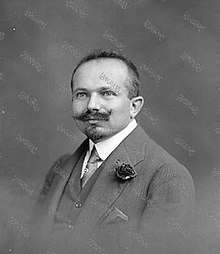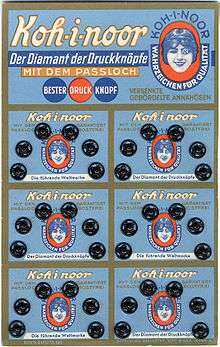Jindřich Waldes
Jindřich Waldes (also Heinrich Waldes or Henry Waldes) 2 July 1876 Nemyšl – 1 July 1941 Havana was a leading industrialist, founder of the Waldes Koh-i-noor Company, Czech patriot of Jewish origin and art collector.

Life

Karel Waldes, father of Jindřich, had an inn and a small haberdashery shop in the village of Nemyšl near the town of Tábor in southern Bohemia. He wanted his son to continue his business but Jindřich found a position of a clerk at the firm of Eduard Lokesch and Son in Prague. This company made buttons and cufflinks. As Waldes had a good knowledge of languages he became Lokesch’s business agent and travelled the world on behalf of the firm. In 1902 together with an engineer Hynek Puc (1856–1938) Waldes left Lokesch and founded his own company Waldes a spol. A year later Puc invented a special machine that inserted a small spring into concealed dress fasteners, the main product of the new firm. The new machine supplemented labour of ten skilled workers. With the increased production Puc kept inventing more machines to support the manufacture of pins, safety pins, needles and buttons. The world-renowned Waldes trademark, Miss KIN, came about in 1912 when Waldes on his ocean trip met Elizabeth Coyne[1] who playfully put one fastener in her eye. František Kupka painted her portrait in oils and Vojtěch Preissig from it designed the firm’s trademark. The other trade names used were Koh-i-noor and Otello.
Waldes Koh-i-noor headquarters were located in Prague suburbs of Vršovice. Soon the company grew to a large concern with branch factories in Warsaw, Dresden, Vienna, Paris, Barcelona and New York City.
On 1 September 1939 Waldes was imprisoned by Gestapo after the Third Reich occupation of Czechoslovakia and kept in concentration camps Dachau and Buchenwald, arriving in Dachau on September 10, 1939 and transferred to Buchenwald on September 26 of the same year. In 1941 his family, who were sent to USA by Waldes before the war (he decided to remain in Prague as a Czech patriot) paid the Nazi authorities 8 million Czech crowns (about 1 Million Reichsmarks or $250,000 US) ransom. In Buchenwald he suffered a diabetic attack, and was in the prison hospital from 11 April 1940 until his release on 2 June 1941. The Gestapo then transported Waldes by plane to Lisbon, Portugal, where he boarded a United States-bound ship. However, Waldes did not survive the journey to the USA and died under suspicious circumstances on the ship which stopped at Havana, Cuba in May 1941.
"He [Waldes] arrived on a Portuguese ship in Cuba. In the moment that he stepped onto solid ground, he broke down and died."[2]
According to witness testimony during a case in the US in the late 1950s, Waldes actually died in a hospital in Havana.[3] He was cremated at a memorial attended by several hundred people on 15 July 1941 at Fresh Pond, Maspeth, in New York.[2]
Waldes was also a passionate art collector of contemporary Czech art. In 1918 in Prague he founded Waldes Museum for his collection of buttons which had over 70 thousand items. The collection was transferred after the Second World War to Museum of Decorative Arts (Uměleckoprůmyslové museum) in Prague. Apart from buttons he collected works of Czech painters especially František Kupka’s paintings. They became friends in 1919 and remained so until 1938. Waldes supported Kupka throughout his career by buying his canvases. Part of Jindřich Waldes’ collection held by the National Gallery in Prague had been returned to his descendants living in the United States.
In 2007 the Prague City Court rendered the decision to return fifty percent of the Czech Koh-i-Noor holdings to the Waldes family heirs. However, in 2010 the Constitutional Court in Brno reversed the decision, stating that the Beneš decrees of 1945 handed the property to the Czech state, not the Communist seizures in 1948.
See also
Literature
- Patrik Šimon: Jindřich Waldes – sběratel umění, Patrik Šimon – Eminent, Praha 2001
- Jiří Waldes a kolektiv: Kupka – Waldes Malíř a jeho sběratel, Petr Meissner, Praha 1999
References
- 'Koh-i-noor Girl', Koh-i-noor Magazin, Volume IV, number 37, January 1933, page 3, as her signature under her photograph confirms.
- Obituary in Aufbau Magazine, New York, July 25, 1941. Translated from the German: "Er kam mit einem portugiesischen Schiff auf Cuba an. In dem Augenblick, da er den festen Boden betrat, brach er zusammen und starb.
- Lauterbach, E: International Law Reports, Vol. 29, Cambridge University Press, 1966, Page 357.
External links
- Museum Kampa, Prague: permanent exhibition of František Kupka's paintings
- Obituary for Heinrich Waldes in the July 25th, 1941 issue of the New York German-language newspaper Aufbau.
- Official website of Koh-i-noor Waldes